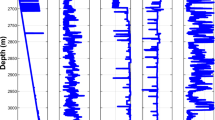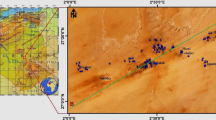Abstract
Prediction of bursting water in a submarine mine (Sanshandao Gold Mine) is very important. The aim of this study was to understand the water sources, mixing ratios, and flow paths in a mining region by using hydrochemistry, principal component analysis (PCA), and rock mechanics. Field observations reveal that there are unusual geothermal gradients and complicated geological conditions. Samples collected from the surface and every depth of the tunnel were analyzed for various ions and isotopes (18O and D). PCA was used to identify the most likely water sources on the foundation of hydrochemistry and a conceptual model. Four kinds of water sources were identified: (1) water mixture of surface freshwater and seawater, (2) brine derived from a deep closed environment, (3) thermal brine derived from the northwestern fault (F3), and (4) Quaternary water. The water sources were variable with time at a sampling site. The combination of water sources in a specific sampling campaign can be decided by the positive scores on principal components (PCs). The PCA results indicate that the first and the fourth kind of water source appear in the deep tunnel with the continual mining activity. Mixing ratio calculations for each sampling campaign show that the first and the fourth kind of water source constitute a small proportion of the total water. The main water sources are the second and third kinds of water. Finally, water flow paths were determined based on the PCA, and rock mechanics is used to explain the change in the water flow paths after excavation. The results show the following: (1) There are several strong water diversion zones that distribute at a certain spacing interval on the large scale and (2) “zonal disintegration” is also found in the tunnel. The fractured zone and the non-fractured zone appear in turn around the tunnel. The rock mass in these two zones represents the tensile and compressive properties, respectively. Thus, volumes of water and permeability of joints and fractures in these two zones are great different.













Similar content being viewed by others
References
Bäckblom G, Martin CD (1999) Recent experiments in hard rocks to study the excavation response: implications for the performance of a nuclear waste geological repository. Tunn Undergr Space Technol 14(3):377–394
Bi H, Ma F, Li K, Ding K (2014) Impact of low temperature geothermal water on mining of Sanshandao gold mine. Chinese J Geol Hazard Control 25(3):89–93
Carrera J, Vázquez-Suñé E, Castillo O, Sánchez-Vila X (2004) A methodology to compute mixing ratios with uncertain end-members. Water Resour Res 40. doi:10.1029/2003wr002263
Cervi F, Borgatti L, Martinelli G, Ronchetti F (2014) Evidence of deep-water inflow in a tectonic window of the northern Apennines (Italy). Environ Earth Sci 72:2389–2409. doi:10.1007/s12665-014-3149-1
Chen B, Wang Z, Ban J, Liu Y (2014) Hydrogeological characteristics and deep water inflow forecast of Sanshandao gold mine. Value Eng 28:95–96
Fernandez G, Moon J (2010a) Excavation-induced hydraulic conductivity reduction around a tunnel—part 1: guideline for estimate of ground water inflow rate. Tunn Undergr Space Technol 25:560–566. doi:10.1016/j.tust.2010.03.006
Fernandez G, Moon J (2010b) Excavation-induced hydraulic conductivity reduction around a tunnel—part 2: verification of proposed method using numerical modeling. Tunn Undergr Space Technol 25:567–574. doi:10.1016/j.tust.2010.04.001
Laaksoharju M, Skårman C, Skårman E (1999) Multivariate mixing and mass balance (M3) calculations, a new tool for decoding hydrogeochemical information. Appl Geochem 14:861–871
Laaksoharju M, Gascoyne M, Gurban I (2008) Understanding groundwater chemistry using mixing models. Appl Geochem 23:1921–1940. doi:10.1016/j.apgeochem.2008.02.018
Li F, Chen X, Zhang Q, Geoff P, Song F et al (2005) Hydrogeochemical characteristics and geochemical evolution model of seabottom groundwater along the east coast of Laizhou Bay. Adv Mar Sci 23(2):190–196
Li G, Wang X, Meng Z, Zhao H (2013) Seawater inrush assessment based on hydrochemical analysis enhanced by hierarchy clustering in an undersea goldmine pit. China Environ Earth Sci 71:4977–4987. doi:10.1007/s12665-013-2888-8
Ma F, Zhao H, Guo J (2015) Investigating the characteristics of mine water in a subsea mine using groundwater geochemistry and stable isotopes. Environ Earth Sci 74:6703–6715. doi:10.1007/s12665-015-4680-4
Martinez JL, Raiber M, Cox ME (2015) Assessment of groundwater-surface water interaction using long-term hydrochemical data and isotope hydrology: headwaters of the Condamine River, Southeast Queensland, Australia. Sci Total Environ 536:499–516. doi:10.1016/j.scitotenv.2015.07.031
Mathurin FA, Astrom ME, Laaksoharju M, Kalinowski BE, Tullborg EL (2012) Effect of tunnel excavation on source and mixing of groundwater in a coastal granitoidic fracture network. Environ Sci Technol 46:12779–12786. doi:10.1021/es301722b
Nakaya S, Uesugi K, Motodate Y, Ohmiya I, Komiya H, Masuda H, Kusakabe M (2007) Spatial separation of groundwater flow paths from a multi-flow system by a simple mixing model using stable isotopes of oxygen and hydrogen as natural tracers. Water Resour Res 43. doi:10.1029/2006wr005059
Peng K, Li X, Wang Z (2014) Hydrochemical characteristics of groundwater movement and evolution in the Xinli deposit of the Sanshandao gold mine using FCM and PCA methods. Environ Earth Sci 73:7873–7888. doi:10.1007/s12665-014-3938-6
Petelet-Giraud E, Negrel P, Gourcy L, Schmidt C, Schirmer M (2007) Geochemical and isotopic constraints on groundwater-surface water interactions in a highly anthropized site. The Wolfen/Bitterfeld megasite (Mulde subcatchment, Germany). Environ Pollut 148:707–717. doi:10.1016/j.envpol.2007.01.030
Pusch R (1989) Alteration of the hydraulic conductivity of rock by tunnel excavation. Int JRock Mech Min Sci Geomech Abstr 26:79–83
Qian Q, Li S (2008) A review of research on zonal disintegration phenomenon in deep rock mass engineering. Chin J Rock Mech Eng 27:1278–1284
Read RS (2004) 20 years of excavation response studies at AECL’s Underground Research Laboratory. Int J Rock Mech Min Sci 41:1251–1275. doi:10.1016/j.ijrmms.2004.09.012
Semar A, Saibi H (2014) Multiparametric cartographic assessment of the hydrochemical groundwater of the Soummam Valley (Kabylia, Algeria). Environ Progress Sustain Energy 33(4):1357–1365. doi:10.1002/ep.11926
Tan H (1993) A study on hydrogeology of Sanshandao gold mine. Mining Res Dev 2(s):73–84
Valder JF, Long AJ, Davis AD, Kenner SJ (2012) Multivariate statistical approach to estimate mixing proportions for unknown end members. J Hydrol 460-461:65–76. doi:10.1016/j.jhydrol.2012.06.037
Vázquez-Suñé E, Carrera J, Tubau I, Sánchez-Vila X, Soler A (2010) An approach to identify urban groundwater recharge. Hydrol Earth Syst Sci 14:2085–2097. doi:10.5194/hess-14-2085-2010
Wang S (2001) Analysis of hydrogeology for deep mining in Sanshandao Gold Mine. Nonferrous Mines 30:10–12
Woocay A, Walton J (2008) Multivariate analyses of water chemistry: surface and ground water interactions. Ground Water 46:437–449. doi:10.1111/j.1745-6584.2007.00404.x
Wu S, Yu Z, Zhou D, Zhang H (2006) Structural features and Cenozoic evolution of the Tan-Lu fault zone in the Laizhou Bay, Bohai Sea. Mar Geol Quat Geol 26:101–110
Yao J, Yu H, Wang S, Ma L (2007) The underground water hydrochemical characteristics of seawater invasion area around Laizhou Bay. Mar Sci 31(4):32–41
Ye B, Peng E (1994) Study on the conducting-water structure model in the Sanshandao Gold Deposit. JCent-southinstMinMetall 25:146–150
Yu MCL, Cartwright I, Braden JL, de Bree ST (2013) Examining the spatial and temporal variation of groundwater inflows to a valley-to-floodplain river using 222 Rn, geochemistry and river discharge: the Ovens River, southeast Australia. Hydrol Earth Syst Sci 17:4907–4924. doi:10.5194/hess-17-4907-2013
Zhang J, Standifird WB, Roegiers JC, Zhang Y (2006) Stress-dependent fluid flow and permeability in fractured media: from lab experiments to engineering applications. Rock Mech Rock Eng 40:3–21. doi:10.1007/s00603-006-0103-x
Acknowledgements
The research was supported by the National Natural Science Foundation of China (Grant Nos. 41372323, 41172271). Grateful appreciation is expressed for the support.
Author information
Authors and Affiliations
Corresponding author
Rights and permissions
About this article
Cite this article
Gu, H., Ma, F., Guo, J. et al. Hydrochemistry, multidimensional statistics, and rock mechanics investigations for Sanshandao Gold Mine, China. Arab J Geosci 10, 62 (2017). https://doi.org/10.1007/s12517-017-2841-3
Received:
Accepted:
Published:
DOI: https://doi.org/10.1007/s12517-017-2841-3




